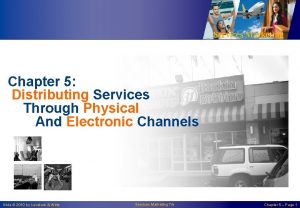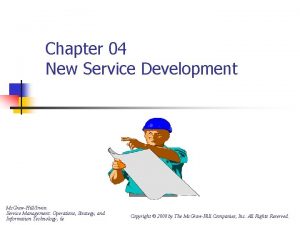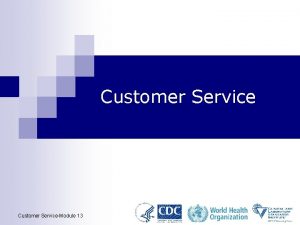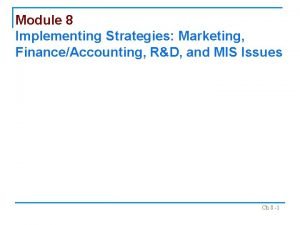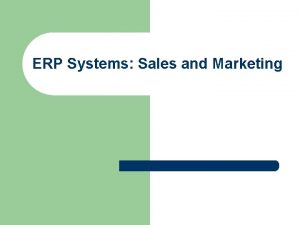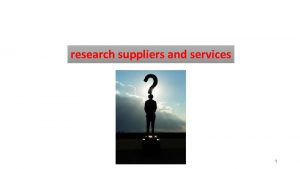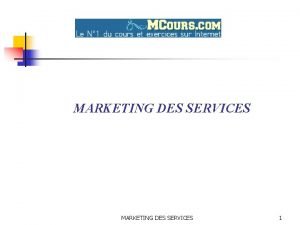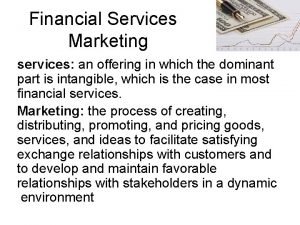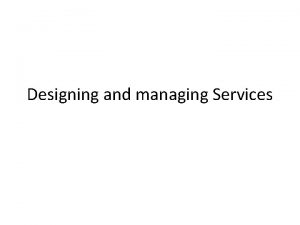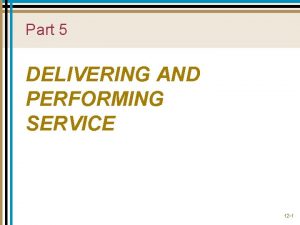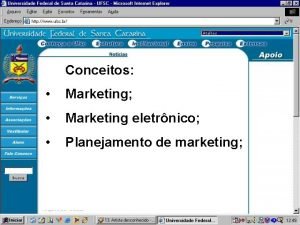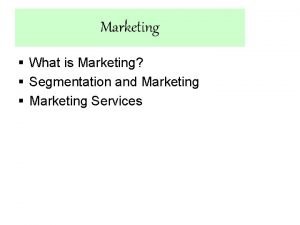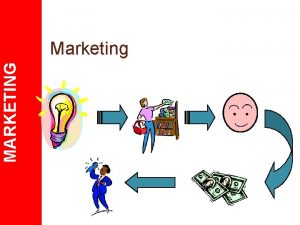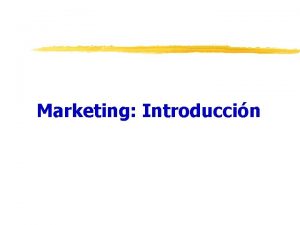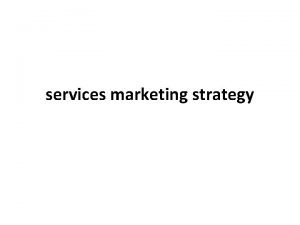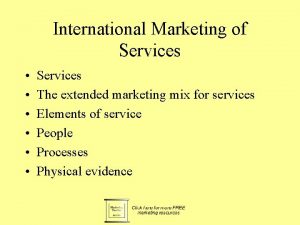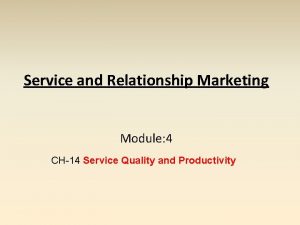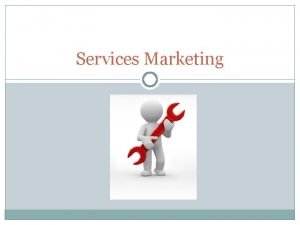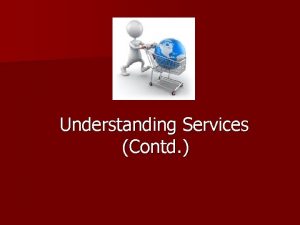MODULE 4 MARKETING OF SERVICES A service is

























- Slides: 25


MODULE 4 MARKETING OF SERVICES A service is any activity or benefit that one party can offer to another that is essentially intangible and does not result in the ownership of anything. Its production may or may not be tied to a physical product. The following factors have stimulated such dramatic growth in services: • Technological advances have created more complicated products (computers, video cameras and cell phones) that require more design, production, promotion and maintenance services. • Organisations are increasingly outsourcing less critical services that were formerly performed internally (cleaning services and payroll processing services). • Social trends in the consumer market, e. g. more working women have lead to an increase in the demand for garden services, housecleaning services, dry-cleaning and day-care for children. • Specialisation by service providers has made functions such as market research and executive recruitment available at lower cost and with better results than can be provided by the users themselves. 2

MODULE 4 THE DISTINGUISING CHARACTERISTICS OF SERVICES INTANGIBILITY It is impossible to taste, smell, feel, see or taste a service. Marketing problems cannot be stored cannot be patented complicated communication process no physical goods to cost Solutions to the problem of intangibility - Visualisation - Association - Physical representation - Documentation http: //www. slate. com/articles/business/rivalries/2013/08/ hertz_vs_avis_advertising_wars_how_an_ad_firm_made_a_ virtue_out_of_second. html � INSEPARABILITY Services are produced and consumed at the same time. Marketing problems - the service provider’s physical connection to the service offered - the involvement of the customer - interaction amongst customers - challenge surrounding mass production Solutions to the problem of inseparability - effective selection and training of contact personnel - effective customer management - mass production - Multiple locations or group sessions 3

4

CHARACTERISTICS OF SERVICES � HETEROGENEITY It is difficult, if not impossible, to achieve standardisation of output. Marketing problems Solutions to the problem of heterogeneity Customisation: leads to better need satisfaction and higher - quality control and standardisation Differs in quality From one service to another From day to day From one branch to another - prices but is more time consuming Standardisation: through intensive training of contact personnel or replacing human labour with machines. Lower prices, faster delivery, consistency of performance, but customers may feel organisation does not care about them. � PERISHABILITY Services cannot be stored. Periods of increased demand cannot be handled through stock keeping as in the case of tangible goods. Marketing problems - Higher demand than supply. Lower demand than supply - Daily variations Monthly variations Seasonal variations Cyclical variations Unpredictable variations Solutions to perishability Demand side: Differential pricing Non-peak demand can be cultivated Complimentary services can be developed Reservation system Supply side: Part-time employees can be hired Peak time efficiency routines Increased customer participation Shared services can be developed Facilities for future expansion can be developed 5

CHARACTERISTICS OF SERVICES OWNERSHIP No ownership is transferred Due to intangibility and perishability Obtain right to service Intermediaries do not take ownership of service only right to distribute service Direct distribution more common is services marketing 6

MODULE 4 CLASSIFICATION OF SERVICES Housing Household services Personal care Recreation and Entertainment Medical and other Healthcare Business and other Professional services Financial services, Insurance and banking Transport Communication Rental of flats, houses and hotel accommodation Repair and maintenance of buildings and equipment, cleaning and gardening services Laundries, dry cleaners hairdressers and beauty salons Sport clubs, holiday resorts, bioscopes, amusement centres and travel agencies All medical services, both private and public Legal, accounting, computer services, marketing research, advice regarding insurance and investments Banking, insurance, investment and loan services Freight and passenger service, car repairs and rental. Telephone and cell phone and specialised communication services 7

Services Doggy day care https: //za. pinterest. com/pin/172896073174321664/? lp=true 8

MODULE 4 STRATEGIC PROGRAMME FOR MARKETING OF SERVICES q Determine objectives q Segmentation, Targeting, Positioning q Plan and develop the Service Mix Service Product strategy Price strategy Place strategy Promotion strategy People Process Physical Evidence 10

MODULE 4 DETERMINE OBJECTIVES 11

. … 1. Use mainly demographic (age, gender, income) and geographic (location, city, suburb) segmentation bases SEGMENTATION DIVIDE TOTAL MARKET INTO SMALLE SUB-SETS WITH SIMILAR NEEDS TARGET CERTAIN SEGMENTS WITH SPECIALLY DESIGNED SERVICE MIX POSITION SERVICE IN MINDS OF CONSUMERS 4. Buying behaviour Attitudes Perception Personality 3. Buying patterns Learning Culture Where, how and when do consumers buy the service? Who has influence on buying decision? 2. Buying Motives Self Actualisation Ego Social Security Physiological 5. Buying Power Is determined by disposable income of consumer Disposable income = Gross income – compulsory payments 12

13

SERVICE PRODUCT STRATEGY SERVICE PROCESSING *** People processing: Possession processing: Information processing: THE SERVICE MIX Service mix consists of service lines Service lines have service items Width and depth of product mix Which services to phase out and new services to add CORE SERVICE AND SUPPLEMENTARY SERVICE = most basic benefit = support or enhance the core service CUSTOMISED SERVICES AND STANDARDISED SERVICES = respond to individual needs, higher price = same service for everybody, difficult to achieve (ATM and car wash) BRANDING AND PACKAGING Can only wrap tangible parts. Create effective brand image by means of: Include a tangible item as part of brand image Tie a slogan in with the brand Use a distinctive colour NEW SERVICES *** Style change: Colour and branding of taxis change Service improvement: Air conditioning; music in taxis (same service, added value) Service line extension: Taxis to airport; Tourist Taxis (In line with current service) New service: Car wash services (Different from current line of service) 14 Innovation: Driver-less taxis. (Not existing before) Examples for Moola’s Taxi Service servicing the commuter market

SERVICE PRICE STRATEGY PRICE OBJECTIVES Revenue oriented: maximising surplus of income over cost (profit) Operations oriented: seeks to match supply and demand by varying prices. Patronage oriented: tries to maximise the number of customers using the service PRICE DETERMINATION Cost based (What it cost to produce service + % profit) METHODS Demand based (What the customer is prepared to pay) Competitor based (The price that competitors are charging) DIFFERENTIAL PRICING • • • for groups of customers (adults, children) for different segments (business class, economy class) for different locations (beach front city, town) for different time periods (peak; off-peak) for different quantities (group theatre bookings cheaper than individual bookings) 15

Differential pricing: Dog day care Below are single dog and puppy rates. Unfortunately, we do not accept dogs/puppies that need daycare less than twice a week (8 times a month), as they battle to find their place within the pack and each day they join us they need to re-establish themselves, which becomes similar to having to redo their assessment each time. Schedule Description Price Per Dog Price Per Day Price Per Month 8 days/month R 98. 00 R 784. 00 3 Day Week 12 days per month R 94. 00 R 1, 128. 00 4 Days Week 16 days per month R 90. 00 R 1, 440. 00 5 Day Week 20 days per month R 86. 00 R 1, 720. 00 2 Day Week 16

If you have 2 or more furry family members please see the schedule below. http: //www. caninecreche. co. za/Contact-Us/ The monthly and daily rates below are for 2 dogs, but the "Per Dog" rate will apply to all dogs where there are 2 or more per family. Schedule Description Price Per Dog Price Per Day Price Per Month Regular Price Discount 2 x 2 Day Week 2 dogs each for 8 days/month R 86. 00 R 172. 00 R 1, 376. 00 R 1, 568. 00 R 192. 00 2 x 3 Day Week 2 dogs each for 12 days/month R 82. 00 R 164. 00 R 1, 968. 00 R 2, 256. 00 R 288. 00 2 x 4 Day Week 2 dogs each for 16 days/month R 78. 00 R 156. 00 R 2, 496. 00 R 2, 880. 00 R 384. 00 2 x 5 Day Week 2 dogs each for 20 days/month R 74. 00 R 148. 00 R 2, 960. 00 R 3, 440. 00 R 480. 00 17

PLACE (DISTRIBUTION) STRATEGY CONVENIENCE OF LOCATION Especially for low-value services ATM’s have increased and on-line banking available Medical services opened in shopping centres NUMBER OF OUTLETS Distribution must meet but not exceed demand Too few outlets = loose customers Too many outlets = unnecessary costs Exclusive / Selective / Intensive distribution DIRECT OR INDIRECT DISTRIBUTION Most services delivered directly Intangible, so no stock to transfer Can make use of service agents, co-production or franchised distribution SCHEDULING Time dependent providers like airlines and dentists, make use of scheduling for even distribution 18

PROMOTION STRATEGY GOALS OF PROMOTION STRATEGY To portray service benefits in an appealing manner To differentiate service from competitors To build a trustworthy reputation FOUR PROMOTIONAL STRATEGIES Stressing tangible cues: concrete symbol of service Using personal information sources: celebrity endorsements; positive word of mouth Creating strong organisational image: physical environment of service facility Engaging in post-purchase communication: post card surveys; telephone calls and follow-up to show customers that their feed-back matters 19

PROMOTION STRATEGY PERSONAL SELLING The service provider is the service in eyes of consumer Service encounter = customers interaction with service employee or tangible element of service Customers form opinion based on service encounter Frontline staff must be trained to view service encounters as opportunity to promote the service SALES PROMOTION Free samples or free visits (can be aimed at staff Money off incentives or customers) Coupons / Vouchers Gift offers Competitions ADVERTISING Difficult to show service in advertisement (intangible) Housing, movies, insurance, transportation make use Professional bodies limit and control advertising by members (doctors, lawyers and accountants) PUBLICITY Personal or non-personal stimulation of demand not paid for. Use press, radio or TV for exposure Part of external relations Many recreation-entertainment services benefit from publicity 20

PEOPLE, PROCESS, PHYSICAL EVIDENCE PEOPLE It refers to the human activities in service delivery It includes contact staff, support staff and customers Management of staff impacts on customer satisfaction Unhappy, underpaid staff cost organisation money Staff should be trained to handle conflict PROCESS Refers to the activities, procedures and mechanisms of service delivery It determines the flow of the service (steps). A service blueprint is used for operation management A blueprint is a flowchart of the service process http: //www. slideshare. net/vicku 1111/service-blueprint http: //www. cooper. com/journal/2014/08/service-blueprints-laying-the-foundation PHYSICAL EVIDENCE Physical environment where service takes place e. g. building, equipment and furniture. It is the tangible part of the service It includes: Ambient factors such as noise, light and temperature Design factors such as interior and exterior décor , furniture and equipment (tangible part of services) Communication factors such as advertising, invoices, membership cards Physical evidence must adhere to requirements for health and safety http: //www. marketingteacher. com/physical-evidence-marketing-mix/ 21

22

23

24

SERVICE QUALITY MARKETERS INTERESTED IN • Offer products that perform CUSTOMER VALUE: • Give consumers more than they expect • Give meaningful guarantees • Avoid unrealistic pricing • Give buyers facts • Build long-term relationships CUSTOMERS EVALUATE SERVICES BY THE FOLLOWING COMPONENTS Reliability: the ability to perform service accurately and consistently every time. Responsiveness: the ability to provide prompt service. Assurance: the knowledge and experience of service provider (trust) Empathy: caring, individualised attention to customers Tangibles: physical evidence (furniture + tools) of the service WHAT MUST MARKETERS DO TO ENSURE CUSTOMER VALUE: q q Understanding customer needs Set service quality specifications Evaluate employee performance Manage service expectations 25

FACTORS THAT DETERMINE CUSTOMER VALUE What must marketers do to ensure customer value? Understanding customer needs Conduct research: surveys or focus groups Employees are also reliable source Complaints are starting point for service improvement Quality is determined by customer Specify quality specifications Set service goals for employees Examples are dress code or telephone etiquette specifications Specifications show commitment to service Evaluate employee performance Service staff key element in management of quality Contact staff often lowest paid / least trained Good evaluation and compensation can enhance employee performance Volume objectives instead of customer relation objectives can lead to unsatisfied customers Manage service expectations SP must be realistic in creating service expectations Set expectations through advertising and promotions SP make promises about the kind of service they deliver Be careful not to over-promise and under-deliver 26
 Principles of marketing grade 12 module 1 answer key
Principles of marketing grade 12 module 1 answer key Distribution in service context
Distribution in service context New service development in service marketing
New service development in service marketing C device module module 1
C device module module 1 Pete sets aside $50 each month
Pete sets aside $50 each month Customer service module
Customer service module Principles of marketing quarter 2 module 9
Principles of marketing quarter 2 module 9 Factors influencing consumer buying decision
Factors influencing consumer buying decision Principles of marketing quarter 1 module 6
Principles of marketing quarter 1 module 6 Principles of marketing module 5
Principles of marketing module 5 Principles of marketing module 10
Principles of marketing module 10 Principles of marketing module 8
Principles of marketing module 8 Marketing mix module
Marketing mix module Erp sales module
Erp sales module Difference between intserv and diffserv
Difference between intserv and diffserv Wake county human services community services center
Wake county human services community services center Types of syndicated data
Types of syndicated data Internal supplier
Internal supplier Brand
Brand Marketing goods and services
Marketing goods and services Partner marketing concierge services
Partner marketing concierge services La servuction en marketing
La servuction en marketing Financial services marketing environment
Financial services marketing environment How to designing and managing service processes
How to designing and managing service processes The pricing tripod
The pricing tripod Service triangle adalah
Service triangle adalah

